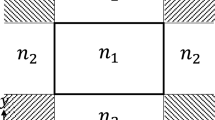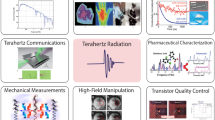Abstract
The analytic inversion of the Method of Auxiliary Sources (MAS) matrix plays an important role in the rigorous investigation of the accuracy of the method. In this paper we investigate the accuracy of MAS when the method is applied to plane wave scattering under oblique incidence by an infinite, dielectric circular cylinder. For this scattering configuration, we prove that the MAS matrix is analytically invertible and hence obtain a concrete expression for the discretization error. A basic contribution of this paper lies in the analytic determination of the auxiliary sources’ locations, for which the corresponding system’s matrix becomes singular. Furthermore, we calculate the computational error resulting from numerical matrix inversion, and compare it to the analytical error. The dependence of both types of errors on the angle of incidence and on the dielectric permittivity is investigated. Finally, error minimization indicates the auxiliary sources’ optimal location.
Similar content being viewed by others
References
Kaklamani DI, Anastassiu HT (2002) Aspects of the method of auxiliary sources (MAS) in computational electromagnetics. IEEE Antennas Propagation Mag 44:48–64
Fairweather G, Karageorghis A, Martin PA (2003) The method of fundamental solutions for scattering and radiation problems. Eng Anal Bound Elem 27:759–769
Zaridze RS, Bit-Babik G, Tavzarashvili K, Economou DP, Uzunoglu NK (2002) Wave field singularity aspects in large-size scatterers and inverse problems. IEEE Trans Antennas Propagation 50:50–58
Leviatan Y (1990) Analytic continuation considerations when using generalized formulations for scattering problems. IEEE Trans Antennas Propagation 38:1259–1263
Doicu A, Eremin Yu, Wriedt T (2000) Acoustic and electromagnetic scattering analysis using discrete sources. Academic, New York
Leviatan Y, Boag A (1987) Analysis of electromagnetic scattering from dielectric cylinders using a multifilament current model. IEEE Trans Antennas Propagation 35:1119–1127
Anastassiu HT, Kaklamani DI, Economou DP, Breinbjerg O (2002) Electromagnetic scattering analysis of coated conductors with edges using the method of auxiliary sources (MAS) in conjunction with the standard impedance boundary condition, (SIBC). IEEE Trans Antennas Propagation 50:59–66
Avdikos GK, Anastassiu HT (2005) Computational cost estimations and comparisons for three methods of applied electromagnetics (MoM, MAS, MMAS). IEEE Antennas Propagation Mag 47:121–129
Anastassiu HT, Lymperopoulos DG, Kaklamani DI (2004) Accuracy analysis and optimization of the method of auxiliary sources (MAS) for scattering by a circular cylinder. IEEE Trans Antennas Propagation 52:1541–1547
Anastassiu HT, Kaklamani DI (2004) Error estimation and optimization of the method of auxiliary sources (MAS) applied to TE scattering by a perfectly conducting circular cylinder. J Electromagn Waves Appl 18:1283–1294
Tsitsas NL, Alivizatos EG, Anastassiu HT, Kaklamani DI (2005) Optimization of the method of auxiliary sources (MAS) for scattering by an infinite cylinder under oblique incidence. Electromagnetics 25:39–54
Anastassiu HT (2005) Error estimation of the method of auxiliary sources (MAS) for scattering from an impedance circular cylinder. Prog Electromagn Res (PIER) 52:109–128
Anastassiu HT, Kaklamani DI (2004) Error estimation and optimization of the method of auxiliary sources (MAS) for scattering from a dielectric circular cylinder. Radio Science 39:RS5015, DOI: 1029/2004RS003028
Heretakis II, Papakanellos PJ, Capsalis CN (2002). Analysis of electromagnetic scattering by infinite conducting cylinders of arbitrary smooth cross section using a genetically optimised technique (GA/MAS). J Electromagn Waves Appl 16, 1555–1572
Larsen NV, Breinbjerg O (2004) An analytical method of auxiliary sources solution for plane wave scattering by impedance cylinders-a reference solution for the numerical method of auxiliary sources. J Electromagn Waves Appl 18:745–761
Heretakis I, Papakanellos PJ, Capsalis CN (2005) A Stochastically optimized adaptive procedure for the location of MAS auxiliary monopoles: the case of electromagnetic scattering by dielectric cylinders. IEEE Trans Antennas Propagation 53:938–947
Balanis CA (1989) Advanced engineering electromagnetics. Wiley, New York
Tai CT (1994) Dyadic green functions in electromagnetic theory. IEEE Press, Piscataway
Warnick KF, Chew WC (2000) Accuracy of the method of moments for scattering by a cylinder. IEEE Trans Microwave Theory Tech 48:1652–1660
Davis PJ (1979) Circulant matrices. Wiley, New York
Author information
Authors and Affiliations
Corresponding author
Rights and permissions
About this article
Cite this article
Tsitsas, N.L., Alivizatos, E.G., Kaklamani, D.I. et al. Optimization of the Method of Auxiliary Sources (MAS) for Oblique Incidence Scattering by an Infinite Dielectric Cylinder. Electr Eng 89, 353–361 (2007). https://doi.org/10.1007/s00202-006-0019-1
Received:
Accepted:
Published:
Issue Date:
DOI: https://doi.org/10.1007/s00202-006-0019-1




